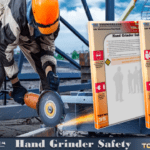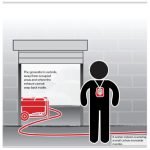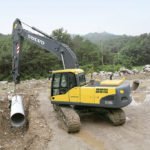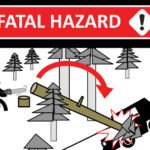Tool Box Talk: Rotary Hammers-Hammer Drills
5 min read

Introduction-Rotary hammers and hammer drills are designed to drill into concrete, brickwork, and hard masonry of all types. They perform those tasks much more quickly than a standard drill and masonry bit, making them a more efficient, cost-effective tool. They are powerful machines and must be operated knowledgeably and carefully to avoid damage to property or injuries to the operator. The following safety rules for rotary hammers/hammer drills will aid supervisors and workers in the safe operation of these tools:
Table of Contents
ToggleUse the following Personal Protective Equipment when using these machines:
- Safety glasses or a face shield
- Gloves
- Dust mask or Respirator (if drilling dust-producing material).
- Hearing protection (Hammer drills are likely to cause noise in excess of 85 decibels)
- Any personnel working adjacent will also need to wear hearing protection and possibly a dust mask.
Using Rotary Hammers and Hammer Drills:
- Supervisors must ensure that employees who operate rotary hammer drills are trained in the safe operation of these tools.
- Understand all of the controls and functions of the drill before use. Do not try to reverse the machine when it is running.
- Debris from this machine can be hazardous to health and to adjacent property.
- Do not use any equipment that is damaged. Do not use taped or repaired cable connections.
- These machines should only be operated on a proper work platform or scaffold; do not use them on ladders.
- Check that machine cables, plugs, and all equipment are sound and ready for use.
- Always use both the stabilizer and side handle when operating rotary hammer drills, adjust it to a comfortable working position.
- Make sure the tool has the capacity to drill the size of hole you require. Never try to enlarge an existing hole or it may jam.
Also Read: Know Handle Hammer safety
- Do not try to reverse the drill while in operation; stop the machine completely first.
- Only use the appropriate drill type for the machine; standard drill bits may shatter creating a safety hazard.
- Always disconnect the drill before changing the drill bits or chisels.
- If you are drilling through a wall make sure that the rubble or debris from drilling will not harm any person or property on the other side of the wall.
- Always make sure there are no hidden electrical lines or pipes before drilling.
- Withdraw the drill often to clear the dust and debris from the hole; this will help to prevent jamming.
- be careful when blowing chips or debris from the hole.
- Keep the air vents on the machine clear and unblocked.
- This is a powerful tool; switch it off if the tool sticks or seems unsafe. If the drill sticks, stop the machine and unwind it by hand.
- Do not use the drill in an explosive or flammable environment. The sparks from the armature could cause an explosion or fire.
Electrical Safety
Use a ground fault circuit interrupter (GFCI) device plugged directly into a power socket. This will help to minimize the risk of an electrical shock by disconnecting the power if a ground fault or short circuit is detected. The GFCI test button should be checked before starting each work task. Reset the GFCI according to the manufacture’s instructions. If you use an extension cable, do not use a cable longer than 100 feet because of voltage drop. Lay extension cables carefully to avoid sharp objects, liquids, or positions that traffic might run over. Unroll the extension fully or the cable can overheat and catch fire!
Conclusion:
During extended use, rotary hammers and hammer drills can cause vibration fatigue to the operator. Regular breaks should be scheduled to prevent fatigue from becoming a hazard to the operator.
Download the Topic
More Tool Box Talks
For more safety Resources Please visit safetybagresources




























